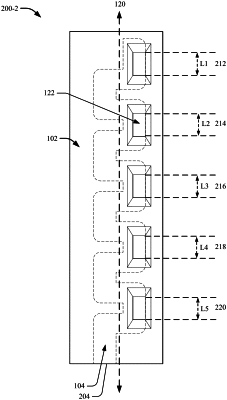| CPC H01Q 13/0233 (2013.01) [H01Q 13/0283 (2013.01); H01Q 13/22 (2013.01); H01Q 21/0043 (2013.01); H01Q 21/005 (2013.01)] | 19 Claims |

|
1. An apparatus comprising a two-part folded waveguide having multiple surfaces that define a channel for a desired wavelength λ, the two-part folded waveguide including:
a first part of the waveguide comprising:
a first surface from the multiple surfaces, the first surface having:
a sinusoidal shape that folds back and forth about a longitudinal axis that extends in a longitudinal direction through the channel; and
a plurality of radiation slots, each of the radiation slots in a shape of a horn that forms a respective hole extending through the first surface and into the channel, wherein a common distance between each horn along the longitudinal axis is one half the desired wavelength λ;
at least one second surface from the multiple surfaces, the second surface being perpendicular to the first surface to define an upper half of walls of the channel that are normal to the first surface; and
one end of the first part defining a portion of a rectangular opening in the longitudinal direction and extending through to the channel;
a second part of the waveguide arranged adjacent to and parallel with the first part, the second part of the waveguide comprising:
a third surface from the multiple surfaces, the third surface being parallel to the first surface and having the same sinusoidal shape as the first surface;
at least one fourth surface from the multiple surfaces between the second surface and the third surface, the fourth surface being perpendicular to the first surface and the third surface, the fourth surface defining a lower half of the walls of the channel; and
one end of the second part defining a remaining portion of the rectangular opening that is not defined by the first part.
|